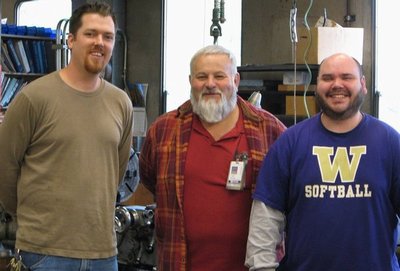June 4, 2009
Facilities Services staffer is a loser, and proud of it

From left, Jason Edwards, Frank Waring and Dean Mussio came up with the idea of a “Biggest Loser” competition among Facilities Services staffers.
Rick Parfitt is a loser. In fact, he’s the “biggest loser” among 18 UW Facilities Services employees who signed up to participate in a weight loss competition inspired by the TV show The Biggest Loser.
Parfitt, a painter who went from 215 pounds to 194, losing 10 percent of his body fat during the 90-day competition, said he’d felt for a long time that he ought to lose weight, but the necessity of having surgery in July for a thyroid condition led him to put his good intentions into practice. “I want to be in the best shape I can be for the surgery,” he said.
He accomplished his goal mainly by changing his eating habits. First, he went from white foods — rice potatoes, pasta, milk — to brown ones, like whole wheat bread and brown rice. Then he stepped up his consumption of salads and fruits. He gave up soft drinks and stopped eating after 6 p.m. As for exercise, well, Parfitt has a physical job. But he also spent his evenings working on his father’s house that he just inherited, thus keeping himself from evening snacking.
“I feel great,” Parfitt said. “I don’t want that weight on me ever again.”
The UW Biggest Loser competition was the brainchild of machinery mechanics Jason Edwards, Dean Mussio and Frank Waring, who talked it up and recruited participants from a number of different shops.

Rick Parfitt may not owe his muscles to the “Biggest Loser” competition in Facilities Services, but he does owe it his trimmer waistline after losing a little more than 20 pounds to become the biggest loser of all.
Each participant anonymously logged the percentage of body fat he or she lost each month. They supported each other by trading healthy recipes, sharing ideas about what was helpful and getting more exercise together — and, of course, being spurred on by the competitive aspect of the challenge.
Maintaining a healthy weight is important for everyone, but for folks in the trades, staying in shape is about more than just looking good and staying active — it’s also about health and safety on the job. “My doctor calls us ‘industrial athletes,'” Edwards said. “All day we’re climbing ladders, twisting, crouching down. At the end of the day, my joints hurt, and I realized I had to do something.”
Like Parfitt, Mussio eliminated soft drinks. And he said that he’s now cooking differently, using more vegetables and leaner meats. “Like when you make tacos, switching out the hamburger for ground turkey — you can’t even tell the difference. . . . I’ve always done a lot of cooking, but now I use more fresh vegetables.”
“And I’ve logged my food — to keep track of what I was eating and calories,” added Waring, who came in second in the competition by losing 8 percent of his body fat.
All the men have made an effort to be more active — taking the stairs instead of elevators, walking more at breaks and crossing campus by foot instead of driving or taking short cuts. They’ve even started basketball games at lunch. But they all agree that the emphasis is on lifestyle changes rather than dieting. “It’s small things, really,” said Mussio.
Many people in the group also signed up on The Biggest Loser Web site for the “Pound for Pound Challenge” through which one pound of food is donated to a local food bank for each pound lost by participants.
Edwards, Mussio and Waring are already planning the next round of The Biggest Loser that will start in July. This time the competition will incorporate teams.
